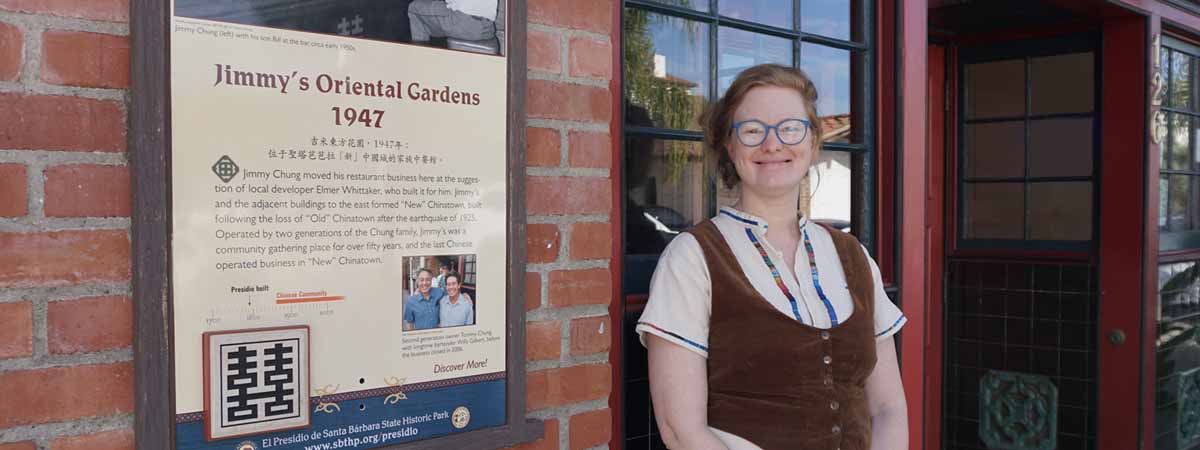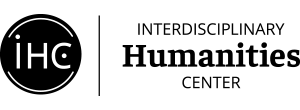
20 Mar Interview with Megan Sheard on Working with the Santa Barbara Trust for Historic Preservation
March 20, 2024
Megan Sheard is a Ph.D. student in the History of Art and Architecture Department. Her research focuses on the materiality of early Tasmanian architecture, in the context of colonial transformation of Aboriginal landscapes and larger webs of regional and imperial trade. As an IHC Public Humanities Graduate Fellow, Sheard worked worked with the Santa Barbara Trust for Historic Preservation.
What projects did you work on as a Public Engagement Fellow with the Santa Barbara Trust for Historic Preservation?
A large portion of my time was spent on content creation for the organization’s public programming for elementary and middle school students. In particular, I created lesson plans as part of the Where We Are From program, which focuses on stories of immigration in the Presidio neighborhood and aims to make connections with the diverse backgrounds and family migration stories of middle school students who visit the site. I also created a resource for lessons to accompany the recently completed Chapel Wedding Projection Project, a silhouetted reenactment of a Spanish colonial-era wedding projected onto an interior wall of the chapel. This was a really fun project for me, as I focused on the material culture of Californio weddings at the cultural histories of some of the objects used, such as imported gold and local abalone shells. In addition to creating lesson materials, I also participated in the Collections Committee, a new language equity initiative that aims to address discriminatory language in the Trust’s research collections and descriptions and to create better search terminology to enhance accessibility.
What experiences during the internship were most impactful for you?
One of the experiences I am most grateful for is the chance to connect with Mia Lopez, a member of the Chumash community and the Trust’s Board of Directors, who was incredibly generous in sharing her perspective on how to include Chumash histories in public education and interpretive site materials. We had a conversation about how institutions might address their obligations to tell Indigenous histories responsibly and without appropriation by addressing the impact of colonization on the land. The interpretive scope the Trust had given me was quite open, and Mia’s advice helped me to move forward with confidence in the environmental and Indigenous cultural history approaches I was hoping to apply. Although not directly related to my role in the internship, it was also profoundly affirming for the methodological approach I had been developing for my own research in Tasmania, in which I focus on the cultural and environmental histories of architectural materials. I don’t think she knew it, but during that conversation I could have cried with delight!
I also learned a lot from the Trust’s resources, which include primary and secondary historical documents, an amazing objects collection, and of course the historic sites themselves. It was great to experience how archival resources get organized within a smaller organization than the university contexts I’ve been used to. I was struck by how the Trust’s local, site-based approach to history supports the telling of stories of national and international significance across a long time span. For example, the histories of Japanese American and Chinese American communities that occupied the Presidio neighborhood in the early twentieth century can be investigated concretely and both linked to, and differentiated from, larger patterns relevant to these communities in US history. Likewise, the transitions between Spanish imperial rule, independent Mexican rule, and subsequent US colonial takeover become less abstract when focused on the consequences for a very specific place in California and the people involved. As a researcher, I know that all research needs some kind of “narrowing device” and experiencing the way the site lent itself to a long story about a small location was really interesting to me. I was also pleasantly surprised to discover how interested I am in working on archives and cataloguing issues—I guess I had never realized how interesting that can be, or how important they are for access and equity.
How did your training as an art and architectural historian prepare you for this work?
As an art and architectural historian, I get really excited by STUFF. So, it was fantastic to spend time with the Trust’s staff who are experts in objects and sites. I was lucky to work in the object collection with the Trust’s truly wonderful archivist Dez Alaniz and to learn about the Presidio site from Mike Imwalle, the Trust’s archaeologist since 1987. Mike knows the place like the back of his hand, was always happy to talk with me about site history and archaeological digs, and could often tell me which articles and dates to look up for my highly specific inquiries! A lot of the educational programs at the Trust are activities-based, and I found that my training in interpreting objects and sites was really useful here. For example, I designed an activity in which students look closely at objects from Jimmy’s Oriental Gardens, the only remaining building of a historic Chinatown in the neighborhood, and use their observations in combination with historical context to imagine the community and activities in the space. I was also able to use my training in reading architectural plans to imagine where Japanese American buildings had stood in the area now occupied by the reconstructed Presidio. The result of this was designing an activity in which students recreate the outlines of those structures using materials relevant to activities that might have happened there. My training in architectural history makes me sensitive to the way things that are there now can seem to have always been, and this helped me to consider how other stories might not only be told but made concrete and visible, even if just temporarily.
One of the most exciting moments for me was the realization that I could mobilize theoretical understandings drawn from studying the architectures of empire and Indigenous material cultures into a format comprehensible to a broad audience, including teenagers and children. This happened while working on the material culture resource for the Chapel Wedding Projection Project, as I realized that investigating seemingly prosaic objects involved in Californio weddings could be linked to themes of empire, syncretism, and Indigenous cultural persistence in concrete ways. For example, Spanish colonial uptake of abalone shells as religious vessels and as a precious material used in objects like altars and pendants draws on a longer history of Californian Native use of abalone; Spanish colonizers’ encounter with it in Arizona proved the existence of an overland route to California, both contributing to colonization and demonstrating the history of Native trade; and the incorporation of abalone into Catholic rites in Santa Barbara was not a simple appropriation but also a way that Chumash people continued to exercise their cultural priorities under duress. Abalone shells hold a beloved place for many Californians and any kid who has wandered on the beaches is familiar with it, so I realized that objects drawn from the places people live in and know can make seemingly abstract academic discussions very concrete and intelligible. It’s a strange and wonderful thing to spend five years neck deep in theory and then one day realize how simple and applicable it can be.
Do you have a sense of how this experience will impact your remaining graduate or post-PhD work?
I hope to stay connected to the work going on in this area and have developed a secondary research interest! Although my dissertation focuses on colonial Australia, it has bridges to this part of the world through the movement of people and architectural materials from Australia to California, especially during the global gold rushes. My learning during the internship provided an incredibly helpful background to a planned portion of my research addressing the importation of Australian timber to California in the late nineteenth century and the significance of the timber trade in using elements of Australian Aboriginal cultural landscapes in colonizing Native lands of California. I’m really grateful to have been given a chance to dig into that history in a context in which I was also producing something useful for public history education.
I also learned a lot from the similarity between the theoretical and practical challenges at Spanish/US colonial sites and British colonial sites in Australia that have active tourism and public history functions. Both deal with the thorny problems of colonization of Indigenous lands, often receiving forms of governmental recognition and support that put pressure on them to produce nostalgic forms of commemoration. They therefore face questions related to contemporary debates about colonial monuments: tear them down, or somehow recontextualize them? The Trust’s ongoing work to recontextualize colonial histories impressed me, including efforts to actively feature stories in public education programs not made visible by the buildings themselves and to involve members of the community whose histories are being represented. It made me hopeful that Australian institutions that commemorate convict history—my research focus area—can make similar changes to the kinds of stories the public hear and who tells them. Seeing this process from inside during my internship made me feel confident that I can contribute to these kinds of changes in the future.
Click here to learn more about the IHC Public Humanities Graduate Fellows Program.

